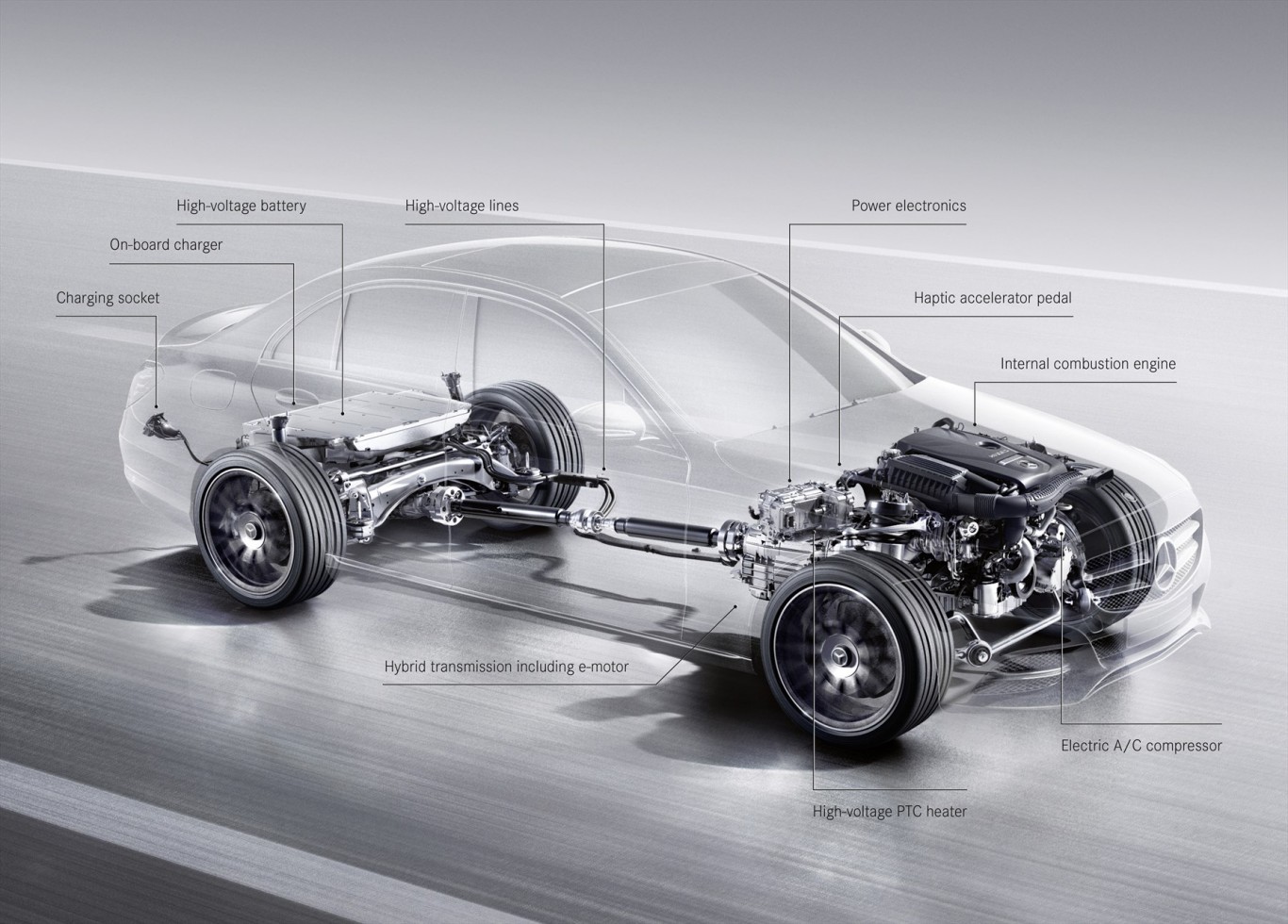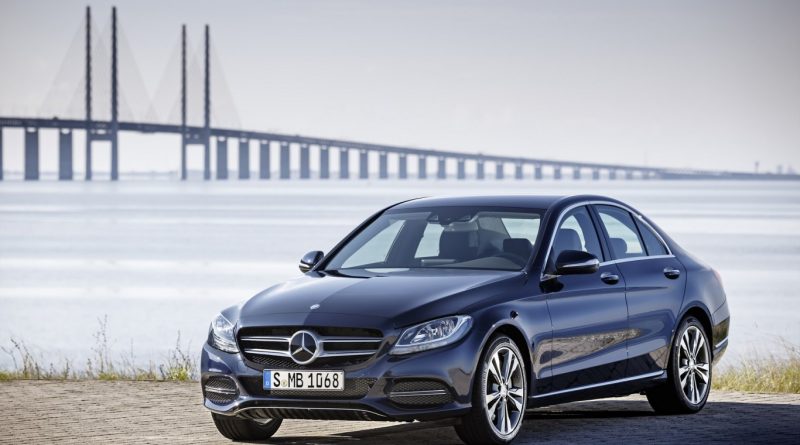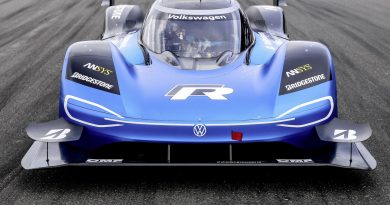The new Mercedes-Benz C 350 e : Efficiency, dynamism and comfort
Following its premiere in the S-Class, Mercedes-Benz is now offering its most advanced hybrid technology in the C-Class. The dynamism and efficiency of the C 350 e sedan makes it a convincing proposition in its segment. With a range of 31 kilometres in purely electric mode, local emission-free driving is now a reality. Its four-cylinder petrol engine, in conjunction with a powerful electric motor, gives it a total system output of 205 kW and torque of 600 Nm. The new C 350 e delivers the performance of a sports car and yet offers certified consumption figures of just 2.1 litres of fuel per 100 kilometres. This corresponds to CO2 emissions of 65 grams per kilometre. The C 350 e is equipped as standard with AIRMATIC air suspension plus a Pre-Entry Climate Control system that can be controlled via the internet, adding up to a truly exceptional level of driving and climate comfort.
C 350 e proudly manufactured in South Africa
A first for the Mercedes-Benz East London plant is the manufacture of a C-Class with the latest PLUG-IN-HYBRID technology for both local and export markets.
“The successful manufacture of the C 350 e sedan at our award winning Mercedes-Benz East London plant to exacting world-class standards, is another milestone in our illustrious 68-year history of engineering excellence,” says Arno van der Merwe, CEO Mercedes-Benz South Africa & Executive Director Manufacturing.
The East London plant celebrated a record milestone of one-million vehicles produced in May 2015 and continues to receive a number of accolades and awards.
Logistics division’s Project Management Specialist, Liebrecht Otto, confirmed that all employees -and contractors involved with the manufacture of these hybrid units were specifically trained to safely work with high voltage components.
“Instructors from TÜV SÜD, an international service corporation focusing on consulting, testing, certification and training, were brought in to the plant to ensure that we met the highest international safety standards. We have now set the benchmark in South Africa for safety, as we do for quality. From a facility perspective, to accommodate some of the additional work content, we installed a new Lifter and High Station in the Assembly area. Additionally, we installed a manipulator on the trim line to aid the operator in securing the new battery into the vehicle,” added Otto.
Thanks to the combination of combustion engine and electric drive, hybrid drive systems deliver impressively low consumption, but with high performance. The electric motor is able to replace or support the combustion engine in situations where the combustion engine does not perform quite so well, and makes practical use of energy generated while braking by converting it into electric energy and storing it.
The C 350 e uses the most advanced form of hybrid technology. Its electrical energy storage unit is a high-voltage lithium-ion battery with a total capacity of 6.2 kWh, which can be charged from an external power source and so makes an effective contribution to the low consumption and emission figures. The battery is water-cooled, weighs around 100 kilograms and is mounted in a sheet steel housing underneath the rear axle in order to maximise crash safety, driving dynamics and boot space.
Thanks to an intelligent on-board charging system, the battery can be recharged in around 1 hour 45 minutes at a wall-box (230 V, 16 A, 3.7 kW single-phase). Alternatively, charging via a standard domestic socket is of course also possible. Depending on the connection, a charge time of around two hours is achievable (with 230 V and 13 A, 3.0 kW). Despite the space taken up by the battery, the C 350 e still has a boot capacity of 335 litres.
PLUG-IN HYBRID for the first time now with four-cylinder petrol engine
In the new Mercedes-Benz C 350 e, this hybrid drive concept is combined for the first time with an efficient four-cylinder petrol engine. From a displacement of just under two litres, it produces 155 kW and maximum torque of 350 Nm. Its direct injection system with spray-guided combustion uses electronically precise controlled multiple injection and fast multi-spark ignition to deliver outstanding performance coupled with high efficiency and exemplary emissions. The electric motor of the C 350 e has an output of up to60 kW and delivers 340 newton metres of torque. A total system output of 205 kW, as well as 600 Nm of torque.
7-speed automatic with additional clutch
The hybrid module of the standard 7-speed automatic transmission 7G-TRONIC PLUS incorporates both the electric motor and an additional clutch between the combustion engine and the electric motor. When driving in all-electric mode, this decouples the combustion engine from the drive train. It also, however, offers the possibility of moving off using the combustion engine but with the performance of a wet start-up clutch. The clutch here is a substitute for the torque converter.
Performance of a sports car
The high overall system output and intelligent engine management give the car the dynamic performance of a nimble sports car. And it combines this with the ride comfort of a premium sedan, along with fuel consumption and environmental compatibility at a level that, until not all that long ago, would not even have been expected of many small cars. This sedan sprints from zero to 100 km/h in 5.9 seconds and reaches a top speed of 250 km/h in conjunction with certified fuel consumption of 2.1 litres per 100 kilometres. This corresponds to CO2 emissions of 65 grams per kilometre. The C 350 e offers the possibility of driving up to 31 kilometres in all-electric mode, and completely free of CO2emissions locally – for example in the city.
A hybrid is efficient, dynamic and completely straightforward to drive
Driving with the new C 350 e is just as easy as with any other automatic vehicle from Mercedes-Benz. You can enjoy its exemplary efficiency and also experience the superb acceleration of the electric motor.
The C 350 e offers all the characteristics of a state-of-the-art hybrid vehicle. These include:
- Silent start: the vehicle starts virtually silently and runs in electric mode. At this point the combustion engine is generally held inactive. Electric output of up to 60 kW is available for driving in all-electric mode.
- Boost: the electric motor kicks in to boost the output of the combustion engine by a further 60 kW – for example for rapid acceleration.
- Energy recuperation: during braking and coasting, energy is recovered and stored in the battery. This energy can then be used at a later stage for electric driving or the boost function.
Making by braking
The greatest potential for lowering the energy consumption of hybrid drive systems lies in maximising energy recovery during coasting and braking. When the brake pedal is depressed, the electric motor initially takes on the job of decelerating, acting here as an alternator. If firmer braking is required, the disk brakes will then intervene mechanically to provide additional grip. This overlap between conventional mechanical braking and the electric braking performance of the electric motor in alternator mode increases effectiveness but remains imperceptible.
Furthermore, the intelligent engine management system of the C 350 e works in the background to select the ideal combination between combustion engine and electric motor.
Impulses for the driver
One new feature of the C 350 e is the so-called haptic accelerator pedal, which helps to reduce fuel consumption and thus also exhaust emissions. It provides two types of information:
- If, when driving in electric mode, the driver’s foot meets a point of resistance on the accelerator pedal, this is an indication that maximum electric performance is being delivered. If the driver continues to depress the accelerator beyond this resistance point, the combustion engine will kick in.
- A double impulse from the ECO Assist function signals that the driver should remove their foot from the accelerator pedal in order to switch off the combustion engine and decouple it from the drive train. Assuming that the driver does what the double impulse suggests, the intelligent engine management system of the C 350 e will vary the deceleration mode between unpowered (sailing) and recuperation, using data from the car’s radar systems as its basis.
Individual transmission mode
The complex technology of the C 350 e makes it no more difficult to drive than a conventional vehicle with automatic transmission. But anyone wanting to can also intervene manually and regulate the hybrid interplay, with the help of five operating modes and three transmission modes. This is done via an operating mode switch and a transmission mode switch located in the centre console. A display in the middle of the instrument cluster shows the current setting.
Selecting a specific transmission mode enables the driver to define certain functions that influence the driving experience.
The following transmission modes are available:
- I Individual: individual definition of the characteristics of the transmission mode, including:
– Drive system
– Chassis and suspension
– Steering
– ECO Assist
– Climate control
- S + Sport+: maximum boost performance, very sporty gear changes, the combustion engine is always active, particularly stiff suspension and damping settings.
- S Sport: enhanced boost performance, sporty gear changes, the combustion engine is always active, stiff suspension and damping settings.
- C Comfort: boost performance and recuperation optimised for comfort and consumption, electric drive/ engine shut-off possible up to 130 km/h, comfort-oriented standard settings.
- E Economy: boost performance is consumption-optimised, recuperation minimised in favour of coasting distance. All-electric mode and engine shut-off are possible. The ECO Assist is also active.
ECO Assist activates an additional function, using the radar technology behind the standard proximity warning system in order to do so. If the radar system identifies a slower-moving vehicle ahead, it sends a double impulse through the “haptic accelerator pedal” to signal the driver to take their foot off the accelerator. The vehicle will then adjust its deceleration automatically, using the electric motor to do so. In this way frequent braking, particularly in stop-and-go traffic, can be avoided.
Choice of four operating modes
In addition to selecting a transmission programme, the driver of the C 350 e can also use the operating mode switch to influence the regulation between electric mode and the use of the combustion engine for driving. In the Eco and Comfort transmission modes, the following operating modes are available:
- Hybrid: all hybrid functions such as electric operating mode, boost and recuperation are available and are applied according to the driving situation and route in the most fuel-efficient manner.
- E-mode: used for all-electric driving – for example in inner-city areas or because the battery holds sufficient charge for the remainder of the journey.
- E-save: the charge status of the battery is maintained – for example to allow all-electric driving in an environmental zone at a later stage in the journey. Electric driving and the boost function are only available for a limited extent.
- Charge: allows the battery to be recharged while driving using the combustion engine – for example in order to ensure a higher state of battery charge for later parts of the journey. The combustion engine remains switched on and fuel consumption may increase. Electric operation is not possible.
In the transmission modes S+ and S, the “hybrid” operating mode is activated. In the “Individual” mode, the choice of available operating modes depends upon the drive system setting.
Route-based operating strategy
The best strategy for efficient operation is anticipatory driving. If the exact destination is known because the relevant data has been entered into the navigation system, charge and discharge of the C 350 e’s high-voltage battery are controlled to ensure the optimal use of energy over the whole route.
Another key point is the requirement that urban areas should be reached with a fully charged battery if possible, so that the vehicle can be driven efficiently in stop-and-go traffic – and frequently in electric mode.
Air suspension as standard
The new C 350 e offers the familiar range of equipment and appointment options that are available for the C-Class and, in addition, includes the enhanced comfort feature AIRMATIC air suspension as part of its standard specification.
Thanks to its electronically regulated continuously variable damper adjustment at both front and rear axle, the air suspension offers outstanding ride comfort with minimal road roar and tyre vibration even when the vehicle is loaded, as well as self-levelling suspension all round.

Three different faces for the PLUG-IN HYBRID as well
The C 350 e comes standard in the AVANTGARDE exterior equipment line, which emphasises its sporty, premium-vehicle character. As an alternative the EXCLUSIVE exterior equipment line and AMG Line is also available. With its classic radiator grille and the three-pointed star on the bonnet, the C-Class conveys prestige status and a sense of modern luxury.
The Mercedes-Benz designers have styled the interior at a level which is rarely encountered even in higher vehicle categories. This is evident from the carefully chosen high-class materials and their pleasant touch and feel as well as from the precision of the finely crafted details. Prominently located immediately above the centre console is a centrally positioned free-standing central display unit. All the functions of the head unit can be intuitively controlled from a touchpad using simple finger movements. Also available: a head-up display that projects important information onto the windscreen directly in the driver’s field of vision.
The C 350 e is fitted as standard with H7 halogen headlamps. In addition to the standard-fit headlamps, two energy-saving LED variants are available: a static system and a dynamic version with the “LED Intelligent Light System”.
Assistance systems for added safety and comfort
The C 350 e offers the same extensive range of safety and assistance systems as all other C-Class models. Two of the systems fitted as standard are ATTENTION ASSIST, which can warn of inattentiveness and fatigue, and COLLISION PREVENTION ASSIST PLUS, which protects against collision at speeds of over 7 km/h and, if the danger remains and the driver fails to react, can also undertake autonomous braking at speeds of up to 200 km/h and by so doing reduce the severity of an accident involving a slower-moving vehicle.
Vibrant infotainment experience
Even the basic version of the sophisticated multimedia system found in the C‑Class is internet compatible, if paired with a Bluetooth®-enabled mobile phone with data option. This enables the internet to be surfed without restrictions when the vehicle is stationary. Also standard is a basic telephony feature, which connects the mobile phone with the vehicle via a standardised Bluetooth® interface.
Extensive know-how in the field of hybrid and electric vehicles
In 1982, at the same time as it was launching the Mercedes-Benz 190, the predecessor to the C-Class, Mercedes-Benz also presented the first concept vehicle with hybrid drive – a two-cylinder horizontally opposed engine served to charge the battery. A number of other experimental vehicles followed until in 2009 the world’s first standard-specification hybrid drive with lithium-ion battery made its debut at Mercedes-Benz: for a long time this S 400 HYBRID was the most fuel-efficient petrol-powered luxury sedan and the most successful hybrid in its segment.
The second-generation hybrid transmission evolved on the basis of the 7G‑TRONIC PLUS automatic transmission. It premiered in 2012 in the E 300 BlueTEC HYBRID, the first diesel hybrid in the premium segment worldwide. By combining the efficiency of a diesel engine with the advantages of the hybrid drive, Mercedes-Benz set another milestone in the development of the automobile and advanced into consumption regions of 4 litres of diesel per 100 km in the luxury saloon segment.
After the E 300 BlueTEC HYBRID, S 400 HYBRID, S 300 BlueTEC HYBRID, C 300 BlueTEC HYBRID and S 500 e, the C 350 e is the latest hybrid model to come from Mercedes-Benz. In the years to come the main emphasis will be on plug-in hybrids. Mercedes-Benz is also a leading player in the field of purely electric mobility. Locally, the S 400 HYBRID, S 500 e and the C 350 e are now available.
The order book for the Mercedes-Benz C 350 e sedan is open at dealerships throughout Southern Africa and delivery of customer vehicles commences August 2016.
As with all Mercedes-Benz passenger cars, the C 350 e comes standard with a class-leading six-year/100 000 km PremiumDrive maintenance plan. The C 350 e is exempt from CO2 emission tax as emission levels amount to frugal levels of 65 g/km and retails at R804 900.
Technical data
| Internal combustion engine | |
| Number of cylinders/arrangement | 4 in-line |
| Mixture formation | High-pressure injection, 1 turbocharger |
| Displacement (cc) | 1991 |
| Rated output (kW at r/min) | 155 at 5500 |
| Rated torque (Nm) | 350 |
| Electric motor | |
| Output (kW) | max. 60 |
| Torque (Nm) | 340 |
| System output (kW) | 205 |
| System torque (Nm) | 600 |
| Acceleration 0-100 km/h (s) | 5.9 |
| Top speed (km/h) | 250 |
| Top speed electric (km/h) | 130 |
| Fuel consumption (combined) from (l/100 km) | 2.1 |
| Combined CO2 emissions from (g/km) | 65 |
| Efficiency class | A+ |
| Electric range (km) | 31 |
| Total battery capacity (kWh) | 6.2 |
| Charge time 10%-100% (230/8 A -16 A), 1.8-3.7 kW(h) |
1.75 – 3.5 |
Also view:
Vehicle Finance, Car Insurance and Road Safety
Buying and Selling a Vehicle – Informed decisions and the Vehicle Retailer




